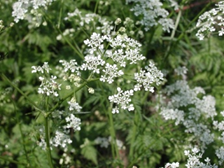Wild Chervil
(Anthriscus sylvestris (L.) Hoffm.)
Family:
Native Range: Europe, West Asia
 Wild chervil, also called cow parsley, is an herbaceous biennial that grows 3–4 feet tall. The hollow stems are branched and covered with soft hairs. The compound, alternate leaves are fernlike—each leaf is divided into leaflets that are also divided. Plants have long taproots that grow up to 6 feet long. During the first growing season, the plant produces a rosette of leaves; the next year the plant produces a stem and flowers. After the seeds ripen, the plant dies. The small white flowers are clustered in flat, compound umbels (within an umbel, each stem is subdivided into a set of smaller stems that bear the flowers). Each flower has 5 notched petals. Fruits are lance-shaped and have a distinct beak; each fruit is about ¼ inch long. Young fruits are green, turning brown when ripe. Wild chervil prefers rich, moist soils, often growing along roadsides and in meadows.
Wild chervil, also called cow parsley, is an herbaceous biennial that grows 3–4 feet tall. The hollow stems are branched and covered with soft hairs. The compound, alternate leaves are fernlike—each leaf is divided into leaflets that are also divided. Plants have long taproots that grow up to 6 feet long. During the first growing season, the plant produces a rosette of leaves; the next year the plant produces a stem and flowers. After the seeds ripen, the plant dies. The small white flowers are clustered in flat, compound umbels (within an umbel, each stem is subdivided into a set of smaller stems that bear the flowers). Each flower has 5 notched petals. Fruits are lance-shaped and have a distinct beak; each fruit is about ¼ inch long. Young fruits are green, turning brown when ripe. Wild chervil prefers rich, moist soils, often growing along roadsides and in meadows.
Reproductive/Dispersal Methods
The seeds of wild chervil are spread by birds and humans; they may be spread by moving operations. Wild chervil also reproduces vegetatively, with new plants sprouting from lateral buds that form at the top of the taproot.
Similar Species
Wild chervil can be confused with Queen Anne’s lace (Daucus carota). However, the leaves of wild chervil are more distinctively fernlike in shape. The umbels of Queen Anne’s lace have bracts below them, while the umbels of wild chervil do not have bracts. Wild chervil usually flowers in mid- to late spring; Queen Anne’s lace flowers later in the season.
Impacts
Wild chervil forms extensive stands that compete with other plants for light, water, and nutrients. The shade of the tall plants may kill the surrounding plants. In some regions, infestations of wild chervil are a serious problem in hayfields and pastures.
Distribution
Native to Europe, wild chervil was originally introduced in seed mixtures designed to represent the wildflowers of British hedgerows and meadows. It now grows throughout the Northeast from Newfoundland south to North Carolina and Tennessee, and west to Minnesota. It occurs in all New England states. Wild chervil is also found in the Pacific Northwest.
Sources and Links:
Invasive Plant Atlas of New England (IPANE)
http://www.eddmaps.org/ipane/ipanespecies/herbs/Anthriscus_sylvestris.htm
USDA Plants Database
http://plants.usda.gov/core/profile?symbol=ANSY
University of Vermont Extension
http://pss.uvm.edu/vtcrops/articles/WildChervil.pdf